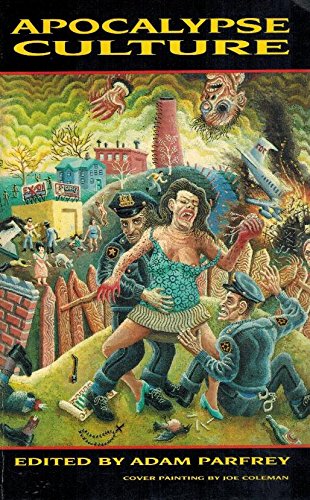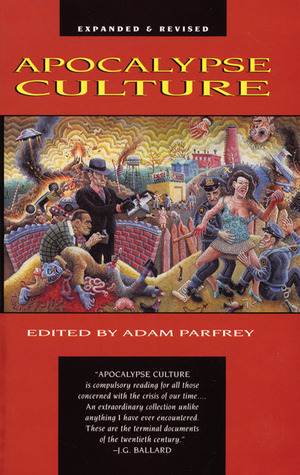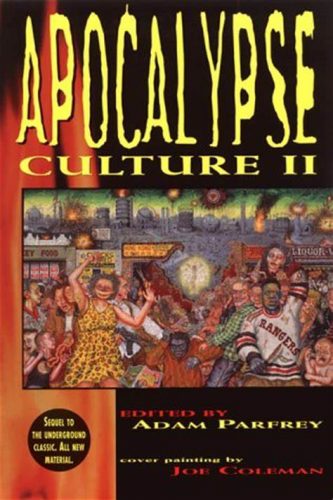 2012 marked the 25th anniversary of the original publication of APOCALYPSE CULTURE. Edited by the late journalist/publisher Adam Parfrey (1957-2018), APOCALYPSE CULTURE is a complacency shattering compilation of articles, interviews and artwork dealing with the abhorrent, apocalyptic and plain weird. It was quite the mindblower back in the day, and its influence was vast, being (in the words of L.A. journalist Scott Timberg) “the book that launched a thousand zines.” The book was initially published by the late Amok Press in 1987, followed by a heavily revised 1991 Feral House version that’s still in print today.
2012 marked the 25th anniversary of the original publication of APOCALYPSE CULTURE. Edited by the late journalist/publisher Adam Parfrey (1957-2018), APOCALYPSE CULTURE is a complacency shattering compilation of articles, interviews and artwork dealing with the abhorrent, apocalyptic and plain weird. It was quite the mindblower back in the day, and its influence was vast, being (in the words of L.A. journalist Scott Timberg) “the book that launched a thousand zines.” The book was initially published by the late Amok Press in 1987, followed by a heavily revised 1991 Feral House version that’s still in print today.
Virtually every spectrum of underground culture is touched upon by APOCALYPSE CULTURE. There’s a Parfrey authored article on modern-day lycanthropy and another with the self-explanatory title “The Unrepentant Necrophile,” in addition to an unabashedly pro-Eugenics piece, an interview with body modification guru Fakir Musafar, an argument against all notions of art, and (in the 1987 edition) possibly the looniest JFK conspiracy screed I’ve ever read—among other things, “King-Kill/33 Degrees” points out that JFK was photographed on the winding stairs of the white house, and “Winding stairs are symbolically important in Masonry.” Plus the Joe Coleman cover painting that adorns both editions is positively eye-popping.
Another distinguishing feature is the book’s intellectual overlay. As Parfrey makes clear in his introduction to the first edition, “APOCALYPSE CULTURE embraces contradictions, draws mental ley lines between revelatory similarities amongst seemingly dissimilar material, and shuns the open-and-shut docu-drama diagnoses of psychological casualty.” Such language permeates the entire book, and may well be the key to its success, satisfying as it does our morbid curiosity in all its permutations while simultaneously making us feel smart.
APOCALYPSE CULTURE can be viewed as the dark and scary inverse of the famed RE/Search books, which were resolutely upbeat in tone and went out of their way to present their subjects in a positive light. Parfrey on the other hand doesn’t seem to have any problem with us  finding the subjects of APOCALYPSE CULTURE’S articles abhorrent (for the record, RE/Search’s V. Vale has publicly dismissed Parfrey as “a racist scumbag” who publishes “purely to foment shock value and to celebrate himself”). Indeed, this book makes it clear (intentionally or not) that fringe figures can be every bit as smug, self-righteous and obnoxious as their establishment counterparts—see “Frank Talk from a Psychopath,” whose subject proclaims “I love myself and my body, and am only obsessed with killing and hurting other people,” and the interview with Pure Magazine’s Peter Sotos, who claims “females are dogs whose only worth is as pawns for my pleasure.”
finding the subjects of APOCALYPSE CULTURE’S articles abhorrent (for the record, RE/Search’s V. Vale has publicly dismissed Parfrey as “a racist scumbag” who publishes “purely to foment shock value and to celebrate himself”). Indeed, this book makes it clear (intentionally or not) that fringe figures can be every bit as smug, self-righteous and obnoxious as their establishment counterparts—see “Frank Talk from a Psychopath,” whose subject proclaims “I love myself and my body, and am only obsessed with killing and hurting other people,” and the interview with Pure Magazine’s Peter Sotos, who claims “females are dogs whose only worth is as pawns for my pleasure.”
If APOCALYPSE CULTURE in both incarnations has an overriding flaw, it’s Parfrey’s oft-obsessive concentration on various subjects. This manifests itself in the many articles on LSD that turn up in the 1987 edition and, more damagingly, the repetitive exposes on secret societies that comprise much of the 1991 edition’s final third. Then there’s the fact that the whole thing is now quite dated, due mostly to the rise of the internet; I doubt even Adam Parfrey could have foreseen how the cyber-verse would so completely usurp his book by providing freaks and weirdoes of all stripes with an infinitely more expansive forum.
Yet APOCALYPSE CULTURE continues to disturb. Just check out the Amazon.com reviews, one of which, dated 2012, proclaims it “the most disgusting book I’ve ever read” and boasts of having gotten it pulled from the shelves of a bookstore. That, I’d say, is a sure sign of the book’s “qualities.”
Inevitably, quite a few APOCALYPSE CULTURE knock-offs have appeared. Most were in the form of “extreme culture” journals—HEADPRESS, RAPID EYE, FUNERAL PARTY, etc.—with layouts and contents suspiciously similar to those of APOCALYPSE CULTURE. The same was true of the 1995 AMOK JOURNAL SENSURROUND EDITION, a “Compendium of Psycho-Physiological Investigations” edited by Parfrey’s former partner Stuart Swezey, and Parfrey’s own 1995 compilation CULT RAPTURE, which with its Joe Coleman painted frontispiece and freaky bent might as well have been titled APOCALYPSE CULTURE II.
 Speaking of which, an APOCALYPSE CULTURE II actually appeared in 2000, even though Parfrey had vowed there would be no sequel (because “How do you grind a sequel out of the end of the world?”). At 458 pages the book is a lot longer than its predecessor, and even more extreme, so much so that its original printer apparently refused to print it (resulting in many offending pictures appearing blacked out). Included are learned exposes on cannibalism, sex slave tomes (including the unforgettable THANKS FOR THE MEMORIES), the Real Doll phenomenon, an organization called Jews for Hitler (which so far boasts a single member who doubles as the group’s founder), and the premiere English translation of the writings of Finnish philosopher Pentti Linkola, who says “If there were a button I could press, I would sacrifice myself without hesitating if it meant millions of people would die.”
Speaking of which, an APOCALYPSE CULTURE II actually appeared in 2000, even though Parfrey had vowed there would be no sequel (because “How do you grind a sequel out of the end of the world?”). At 458 pages the book is a lot longer than its predecessor, and even more extreme, so much so that its original printer apparently refused to print it (resulting in many offending pictures appearing blacked out). Included are learned exposes on cannibalism, sex slave tomes (including the unforgettable THANKS FOR THE MEMORIES), the Real Doll phenomenon, an organization called Jews for Hitler (which so far boasts a single member who doubles as the group’s founder), and the premiere English translation of the writings of Finnish philosopher Pentti Linkola, who says “If there were a button I could press, I would sacrifice myself without hesitating if it meant millions of people would die.”
Yet for all its provocation APOCALYPSE CULTURE II is considerably less impacting than part one. The biggest problem? Parfrey saw fit to include a lot of “star” contributors—ANSWER ME’S Jim Goad, Unabomber Ted Kaczynski, Boyd Rice, Colin Wilson, Sondra London and Crispin Glover—who more often than not have little to say. For the record, Colin Wilson profiles the Japanese murderer Issei Sagawa and Jim Goad dramatizes the events that got him incarcerated, while Glover’s contribution, titled “What is It?,” slams Steven Spielberg at some length (thus succeeding in promoting Glover’s self-directed film of the same name and airing his outrage over the fact that he was dropped from the Spielberg produced BACK TO THE FUTURE sequels).
Was an APOCALYPSE CULTURE III ever on the horizon? Had Parfrey lived a bit longer I wouldn’t have ruled out the possibility, as there’s no shortage of potential subject matter. As Parfrey once claimed, “I keep thinking you can get to the bottom of human behavior, that it can never get any more sordid or pathetic, but I’m always wrong.”
